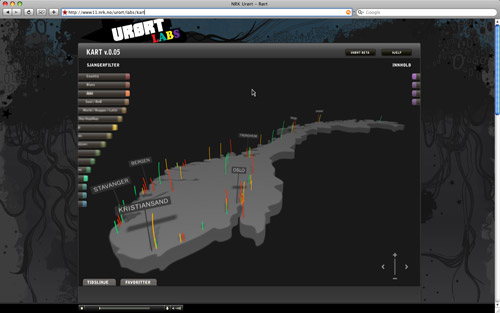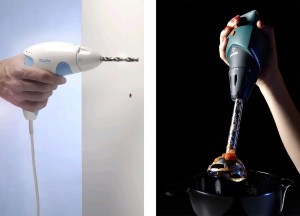NORDES
Presentation: Social Navimation
Yesterday I presented my paper on Social Navimation at the NORDES conference Engaging Artifacts. I used the online presentation tool Prezi to create the visual presentation, which includes videos of interfaces I have designed. The videos are also available at the Design page.
How to see the presentation: use the buttons in the lower right corner. The second button opens the presentation in full screen, while you push the button to the right to go further in the presentation.
Social Navimation is the phenomenon of engaging with social media through a navimational interface, or more specifically, to intertwine navigation with motion in
social media applications. In this paper I analyse a set of design examples of how social navimation can be realised.
I got a lot of positive comments after the presentation, especially on the visual presentation. Overall I am happy with the Prezi tool, even if I have discovered some bugs. It took me quite some time to make the presentation, but now I know the tool and will definitely use it for future presentations.
Workshop: Designing dynamic interfaces for mobile devices
 |
Are you compelled by the rapid development of mobile devices and their graphically sophisticated screens?
Have you noticed the increasing employment of visual motion in screen-based interfaces?
Are you interested in the possibilities and challenges for designing such interfaces?
Jørn Knutsen and I will arrange a full day workshop at the NORDES conference Engaging Artifacts in Oslo, August 30 – September 1, 2009. We will introduce participants to theoretical concepts and design techniques for prototyping screen-based interfaces that make use of visual movement. Participants will work hands-on in groups, exploring techniques for developing simple prototypes. The workshop ends with a general discussion in which we address theoretical as well as practical issues.
Full workshop description (PDF).
Conference program. NB: early registration until August 1.
UPDATE: The workshop was cancelled.
To be presented: Social Navimation
 |
I will present a full peer-reviewed paper on the Nordic Design Research conference NORDES’09: Engaging Artefacts, which will take place in Oslo in the end of August this year. The paper is called ‘Social Navimation: Engaging Interfaces in Social Media’, and explores how visually dynamic interfaces can enhance social media applications. This potential is investigated through experimental design production, followed by a textual analysis of the resulting interface prototypes. The term ‘social navimation’ is introduced and applied in the analysis, in which I investigate how semiotic resources from navimation are connected to features of social media. Hopefully, the paper will be of interest for both theory and practice of interface and interaction design, and new media studies in general.
UPDATE: The conference program and all papers are now available here. Download the full paper: Social Navimation: Engaging Interfaces in Social Media (PDF).
UPDATE 2: See the presentation.
Materialising gender
Some time ago I wrote a blogpost where I suggested that design (or more specifically the production of artefacts other than the traditional academic paper) can be used for intentionally communicating theoretical issues. I believe we to a certain degree can embed, present and visualise theory in artefacts by making use of specific resources for meaning-making, just like we do when we design. Of course, this raises questions of interpretation: to what degree is the “reader” able to understand what is to be communicated through the artefact? This is a huge theoretical question that I am not going to go into here. However, I will provide an example that I find interesting in terms of how designer skills and design production can help communicate a theoretical argument.
The example is from a master project in industrial design at Konstfack by Karin Ehrnberger, called ‘Materializing gender’. I saw this presented on the design conference NORDES in Stockholm in 2007, and was impressed by how the theoretical discussion was interwoven with a specific design project. The paper is unfortunately not available online, but a short description can be found here.
The aim of the paper was to investigate how products are ‘gender coded’, and bring attention to the lack of understanding of this phenomenon. This was partly done theoretically by drawing on gender studies, but also through experimental design production. Ehrnberger designed a hand mixer using the aesthetics of a drill, and a drill using the aesthetics of a hand mixer (images used with permission from the designer).
Even though these artifacts do not convey a unambiguous argument in themselves, they are to my mind highly successful in visualising and bringing attention to how gender is semiotically “encoded” in physical products. These artefacts do not reduce the need for theory and analysis, rather they demonstrate the importance for a thorough and theoretical inquiry. In addition, these products have the ability to evoke reactions from both researchers, designers, and users, and thereby increase the potential for knowledge dispersion.
In my research I intend to do something similar, that is to experiment with form of academic communication. Rather than keeping the design production and the academic text separate, I want to integrate them in a coherent whole. To put it simple: I will discuss and analyse navimation through a navimational interface. I have already done a small experiment and plan to take this further in some way or another. This is not easy to do in regards to both design and research, but I think there is a great potential for innovation in academic communication here.
Search
Recent posts
- SpotTrack: Award for Design Excellence
- VizBox Bergen og årets geogründer
- Fulbright report: six months at the School of Cinematic Arts in Los Angeles
- The VizBox Experiments
- TopoBox: exploring a tangible dataviz platform
- Norway in 3D part I: from DEM to 3D surface
- Using visualization for understanding survey data
- Story kicking big data
- Fulbright project: Dynamic Information Visualization
- Visiting Fulbright scholar at USC in Los Angeles
- (E)motional design paper at DANDE2012
- 3,5 års arbeid på 6 minutt og 40 sekund
- PhD thesis online
- New video: Kinetic Interface Design
- Presentasjon: Skisser utanfor boksen
